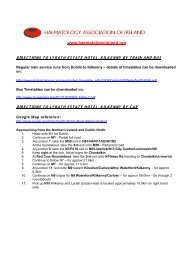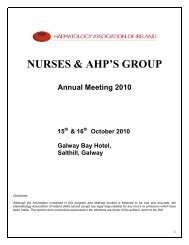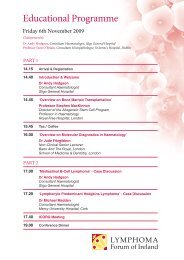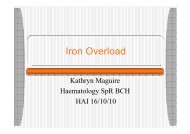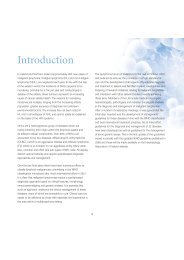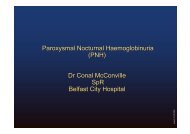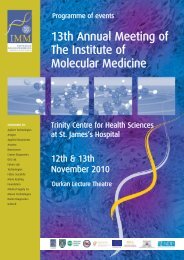Guidelines on Diagnosis and Treatment of Malignant Lymphomas
Guidelines on Diagnosis and Treatment of Malignant Lymphomas
Guidelines on Diagnosis and Treatment of Malignant Lymphomas
You also want an ePaper? Increase the reach of your titles
YUMPU automatically turns print PDFs into web optimized ePapers that Google loves.
Diffuse Large B-Cell Lymphoma<br />
Definiti<strong>on</strong> <strong>and</strong> Incidence<br />
Diffuse large B-cell lymphoma (DLBCL) is composed <strong>of</strong><br />
B lymphoid cells with nuclear size equal to or exceeding<br />
macrophage nuclei or more than twice the size <strong>of</strong> a normal<br />
lymphocyte. DLBCL accounts for about 30% <strong>of</strong> cases <strong>of</strong> n<strong>on</strong>-<br />
Hodgkin Lymphoma with an incidence <strong>of</strong> 4 cases/ 100,000/ year.<br />
The incidence increases with age from 0.3 at 35-39 years to<br />
26.6 at 80-84 years. The median age <strong>of</strong> diagnosis is 64 years<br />
with an equal sex ratio. In recent decades the incidence has<br />
been increasing independent <strong>of</strong> HIV infecti<strong>on</strong> as a risk factor.<br />
ICD – O Code: 9680/3<br />
Clinical Presentati<strong>on</strong><br />
DLBCL can present with nodal or extranodal disease, with up to<br />
40% <strong>of</strong> cases presenting with extranodal disease. The most<br />
comm<strong>on</strong> extranodal site is the gastrointestinal tract (mainly<br />
stomach <strong>and</strong> ileocaecal regi<strong>on</strong>) but the disease can present at<br />
virtually any locati<strong>on</strong> including skin, central nervous system<br />
(CNS), b<strong>on</strong>e, testis, s<strong>of</strong>t tissue, salivary gl<strong>and</strong>, female genital<br />
tract, lung, kidney, liver, Waldeyer’s ring <strong>and</strong> spleen. Primary<br />
presentati<strong>on</strong> with b<strong>on</strong>e marrow or peripheral blood involvement is<br />
rare. Primary mediastinal large B-cell lymphoma differs in that the<br />
disease is limited to the mediastinum <strong>and</strong> is seen more frequently<br />
in women between 20-40 years. Patients typically present with a<br />
single, rapidly enlarging mass which <strong>on</strong> staging may be more<br />
disseminated. Transformed DLBCL following an indolent<br />
lymphoma such as chr<strong>on</strong>ic lymphocytic leukaemia/ small<br />
lymphoctic lymphoma (CLL/SLL), follicular lymphoma, marginal<br />
z<strong>on</strong>e B-cell lymphoma or lymphocyte predominant Hodgkin<br />
lymphoma is well described. Underlying immunodeficiency <strong>and</strong><br />
auto-immune diseases are significant risk factors <strong>and</strong> are<br />
frequently associated with Epstein-Barr virus (EBV) positivity.<br />
DLBCL replaces the normal architecture <strong>of</strong> the lymph node or<br />
tissue <strong>of</strong> origin diffusely, though the infiltrati<strong>on</strong> can be partial,<br />
inter-follicular or rarely sinusoidal. The perinodal s<strong>of</strong>t tissues are<br />
<strong>of</strong>ten infiltrated. DLBCLs are morphologically diverse including a<br />
number <strong>of</strong> specific subtypes <strong>and</strong> specific entities (see below) <strong>and</strong><br />
a large number <strong>of</strong> cases which are grouped together as DLBCL<br />
not otherwise specified (NOS). DLBCL NOS includes the<br />
comm<strong>on</strong> morphologic variants centroblastic, immunoblastic <strong>and</strong><br />
anaplastic in additi<strong>on</strong> to rare morphologic variants. DLBCL NOS<br />
can also be divided into subgroups based <strong>on</strong> immunophenotype<br />
(CD5+, Germinal centre B cell-like (GCB), n<strong>on</strong>-GCB) or based<br />
<strong>on</strong> gene expressi<strong>on</strong> pr<strong>of</strong>ile (Germinal center B cell-like (GCB)<br />
<strong>and</strong> activated B cell-like (ABC)) although use <strong>of</strong> these subgroups<br />
to determine therapy is not currently recommended.<br />
Specific subtypes <strong>of</strong> DLBCL include T cell/histiocyte rich DLBCL,<br />
Primary CNS DLBCL, Primary cutaneous DLBCL (leg type) <strong>and</strong><br />
EBV positive DLBCL <strong>of</strong> the elderly.<br />
Specific DLBCLs with characteristic clinicopathological features<br />
include Primary mediastinal large B cell lymphoma, Intravascular<br />
large B cell lymphoma, DLBCL associated with chr<strong>on</strong>ic<br />
inflammati<strong>on</strong>, Lymphomatoid Granulomatosis, ALK-positive large<br />
B cell lymphoma, Plasmablastic lymphoma, Primary effusi<strong>on</strong><br />
lymphoma <strong>and</strong> Large B cell lymphoma arising in HHV-8<br />
associated Castleman’s disease.<br />
32




